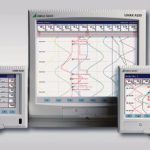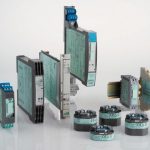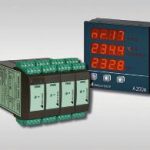Camille Bauer AG looks back on a company history of 60 years. During this period, the small garage venture producing electric instruments has grown into an internationally operating specialist for heavy current and angular position engineering as well as process instrumentation. cpp visited Camille Bauer in Wohlen and talked to the director, Max Ulrich, and the product manager, Ralph Schöpflin, about the company and different components for process instrumentation.
The product program of Camille Bauer is subdivided into the areas of heavy current, angular position and process instrumentation. Heavy current instrumentation comprises measuring devices for voltage, electrical current, power, phase angle and position, energy counters as well as facilities for current quality evaluation. The main buyers of such products are companies engaged in power generation and power distribution as well as utilities. “We are addressing a completely different target group with our angular position instrumentation”, Max Ulrich, director of Camille Bauer AG, explains. “These instruments for the acquisition and analysis of angle, position and level or volume are successfully employed in mechanical and plant engineering. Since some of the instruments are also available for ex-applications, they are used in tank farms or valve position control in the chemical and petrochemical industry.” Camille Bauer focuses both on these sectors and the food and pharmaceutical industry when marketing prod-ucts for process instrumentation. These comprise temperature instruments as well as facilities for safe signal isolation, conversion and amplification and a well-balanced program of videographic recorders. The paperless devices acquire, visualise and store process variables. In addition, there are extensive analysis functions for modern process management.
Low maintenance videographic recorder
The videographic recorders of the Linax A300 family are modular in design and have a housing ingress protection of IP 66/Nema 4x. They may be used in all facilities requiring validation according to FDA 21 CFR Part 11. The A310, A320 and A330 videographic recorders form part of the Linax series. “The recorders are different in relation to their screen size and performance,“ Ralph Schöpflin, product manager for process instrumentation, explains. “The screen of A310 is 12.5 cm, of A320 14 cm and of A330 31 cm. While A310 and A320 have 12 universal inputs, users can work with 36 channels in A330. An essential advantage of all recorders is the fact that they may be equipped with different types of cards. The range includes analog and digital input cards as well as Ethernet communication cards and Modbus cards. This facilitates the easy adaptation of Linax videographic recorders to the most varied needs of users.“
Another important aspect is the internal storage capacity of the devices. It amounts to 1 MB for A310, 8 MB for A320 and A330 respectively. Flash memories ensure that data is not lost in a power cut. In addition, the memories have a special algorithm for error recognition and correction which, according to Schöpflin, guarantees absolutely safe storage of data.
High degree of data security guaranteed
The following measures achieve very high data security standards: The recorders may be secured by seals and the memory drive can be locked. Protection by passwords is available for all user levels. Every recorder access is electronically recorded. Data integrity is secured by the application of an electronic safety signature to transferred data. Another advantage of Linax A300 videographic recorders is the meticulous record of all events and data in form of alarm, summation and system or monitoring protocols.
Users can select different views for process data representation and adapt them to their needs. A digital data and process view as well as different graph views (bar, circle, trend, cascade, etc.) are available among others. Linax A300 videographic recorders are operated via keys with clearly allocated functions. Schöpflin adds: “Data can also be directly entered into A320 via touchscreen. The menu-guided operation and configuration of the recorders is oriented to common Windows programs. Users can download emulation software free of charge from our homepage and configure their videographic recorders comfortably at the PC.“ The chemical and pharma-ceutical industry uses Linax recorders mainly to monitor temperature, pressure and levels.
Temperature instrumentation with a system
Temperature is one of the most frequently measured parameters in process industry. This is also reflected by the extensive temperature instrumentation program of Camille Bauer. It comprises different temperature sensors as well as temperature transmitters and control systems of the Sineax line.
Temperature sensors are available in different designs, e.g. as jacketed thermometers, cable sensors or slot resistance thermometers. Resistance thermometers (PT100, PT1000, etc.), different types of thermocouples or special sensors like Pt10, Pt25, Pt46 or Ni100 are employed as sensor elements. Different process connections are available. The spectrum ranges from simple thread connections and flanges through to welding bosses. Schöpflin adds: “We offer temperature sensors with clamp, Varivent and Neumo process connections particularly for the food and pharmaceutical industry.“
Camille Bauer provides the temperature transmitters of the Sineax line in two versions: Transmitters for top-hat rail mounting and head transmitters. “The latter are directly installed in the head of the temperature sensor,” Schöpflin states. “Users enjoy the advantage of a short and thus safe line between sensor and transmitter which generates a stable 4…20 mA signal. The signal is then transmitted to units downstream, e.g. our Sineax temperature controller.“ Sineax temperature transmitters for top-hat rail mounting are available in two-wire technology with a fixed and programmable measuring range as well as in a programmable four-wire versions with or without a second measuring channel. Sineax head transmitters are provided in a similar variety. They are available with a fixed or programmable measuring range or as Hart and Profibus PA instruments. Some of the transmitters are also provided in explosion protected versions.
Sineax temperature controllers are the logical completion of the temperature instrumentation program of Camille Bauer. Contrary to traditional temperature controllers in compact design, the VR 660 Sineax controllers are top-hat rail modules. “Every module is an independently working controller which is programmable via an interface and serves one control loop,“ Schöpflin explains. “However, it is also possible to combine up to 32 Sineax VR 660 temperature controllers to a complete, safety-oriented controller system via the A200R display and operating unit. The master unit assumes two functions: It handles the communication of the individual controller modules among each other via Modbus and facilitates visualising and operating the controller system outside of the control cabinet.“
Sineax temperature controllers are parameterised via the TempCo 600 configuration and service software. For example, users can store the sensor type and determine whether the Sineax temperature controller should work as a two-state or three-state controller with TempCo 600. (le)
cpp 447
Data Sheet Linax A310
Data Sheet Linax A320
Temperature controller system VR660
Alternating company history
At the end of the second world war, the demand for panel displays for electric variables and portable voltmeters was very big in Switzerland. These were precisely the products with which Matter, Patocchi & Co. AG started in Wohlen in 1944. A little later, in 1947, Camille Bauer AG, a Basel trading company and Swiss sole representative of Hartmann & Braun products, bought the garage venture in Wohlen. In 1956, the company was renamed to Camille Bauer Messinstrumente AG. The latter was acquired by the Mannheim Röchling group in 1979 and continued as an independent company within the group until 1991. After Gossen and Metrawatt had been acquired by Röchling the three enterprises were combined to the GMC Instruments group domiciled in Nürnberg in 1992. In 2005, the GMC group was sold to the Berlin capiton AG, a renowned investment company.
Camille Bauer generated sales of 18 million CHF in 2005. At the Wohlen site, the medium-sized company employs a staff of 92 in the areas of production, product development, marketing and international sales. In addition, the GMC group operates its own national and international sales companies under the name of GMC Instruments.
Share:










